Bounce Fitness: Registration and Fitness Trends Report
VerifiedAdded on 2023/04/23
|17
|3986
|310
Report
AI Summary
This report provides a comprehensive analysis of Bounce Fitness, examining its registration requirements and the broader trends within the Australian fitness industry. The report delves into various aspects, including the application of Robotic Process Automation (RPA) and Artificial Intelligence (AI) in information management, correlation calculations, probability assessment, and the use of linear programming and queuing theory in business decision-making. It also explores the importance of a robust risk management plan. The case study focuses on the registration of four fitness centers, the implications of unqualified trainers, and the significance of adhering to Fitness Australia's code of conduct. Furthermore, the report investigates the current trends in the Australian fitness industry, including participation rates, shifting trends, and the impact of social media. The analysis includes data on participation by age, sex, and state, along with a 'what-if' analysis to assess the potential impact of changes in the number of organized fitness centers. The report concludes with recommendations for information collection and management, ensuring the logical approach used in the evaluation, and the reliance on evidence-based data.
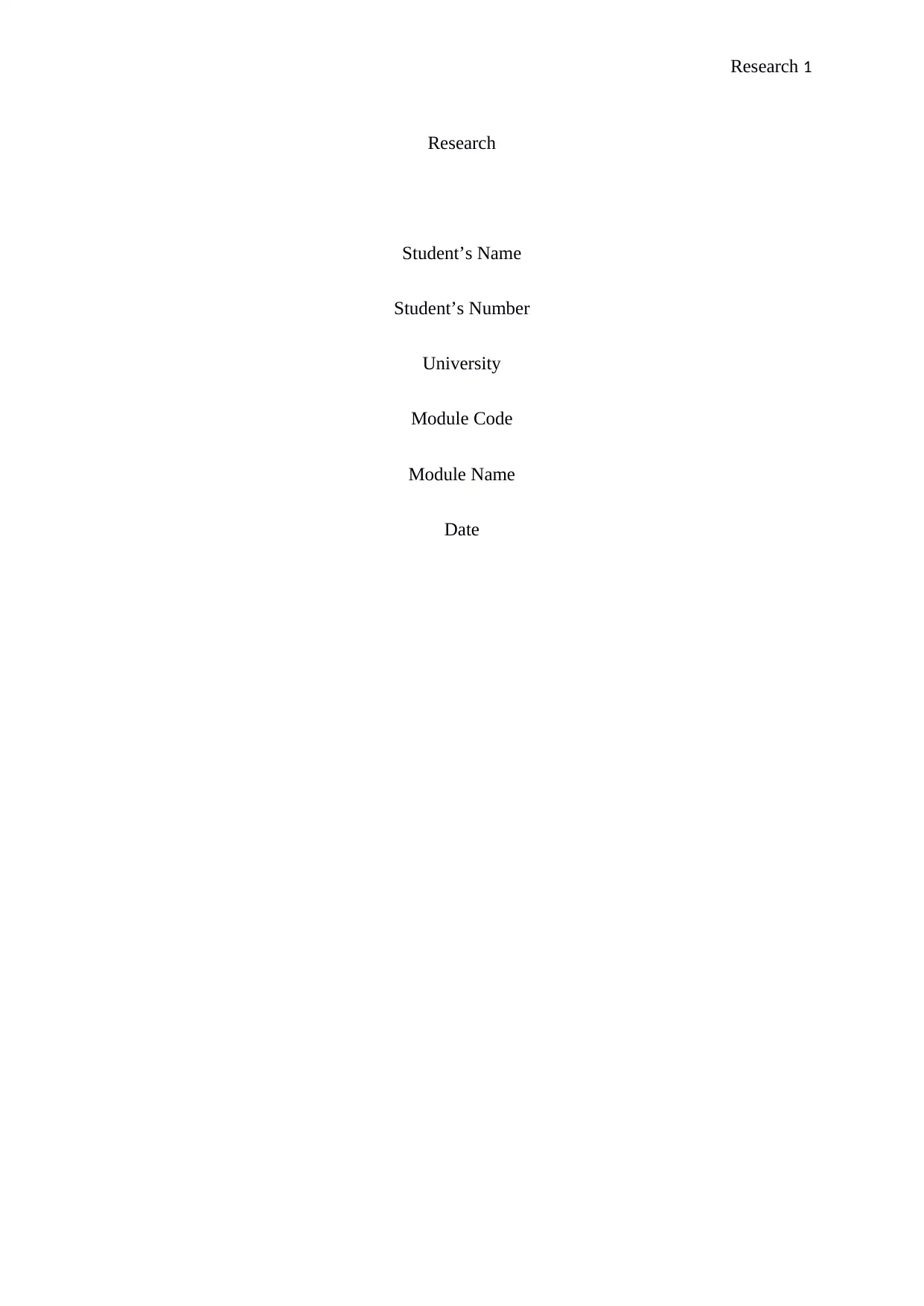
Research 1
Research
Student’s Name
Student’s Number
University
Module Code
Module Name
Date
Research
Student’s Name
Student’s Number
University
Module Code
Module Name
Date
Paraphrase This Document
Need a fresh take? Get an instant paraphrase of this document with our AI Paraphraser
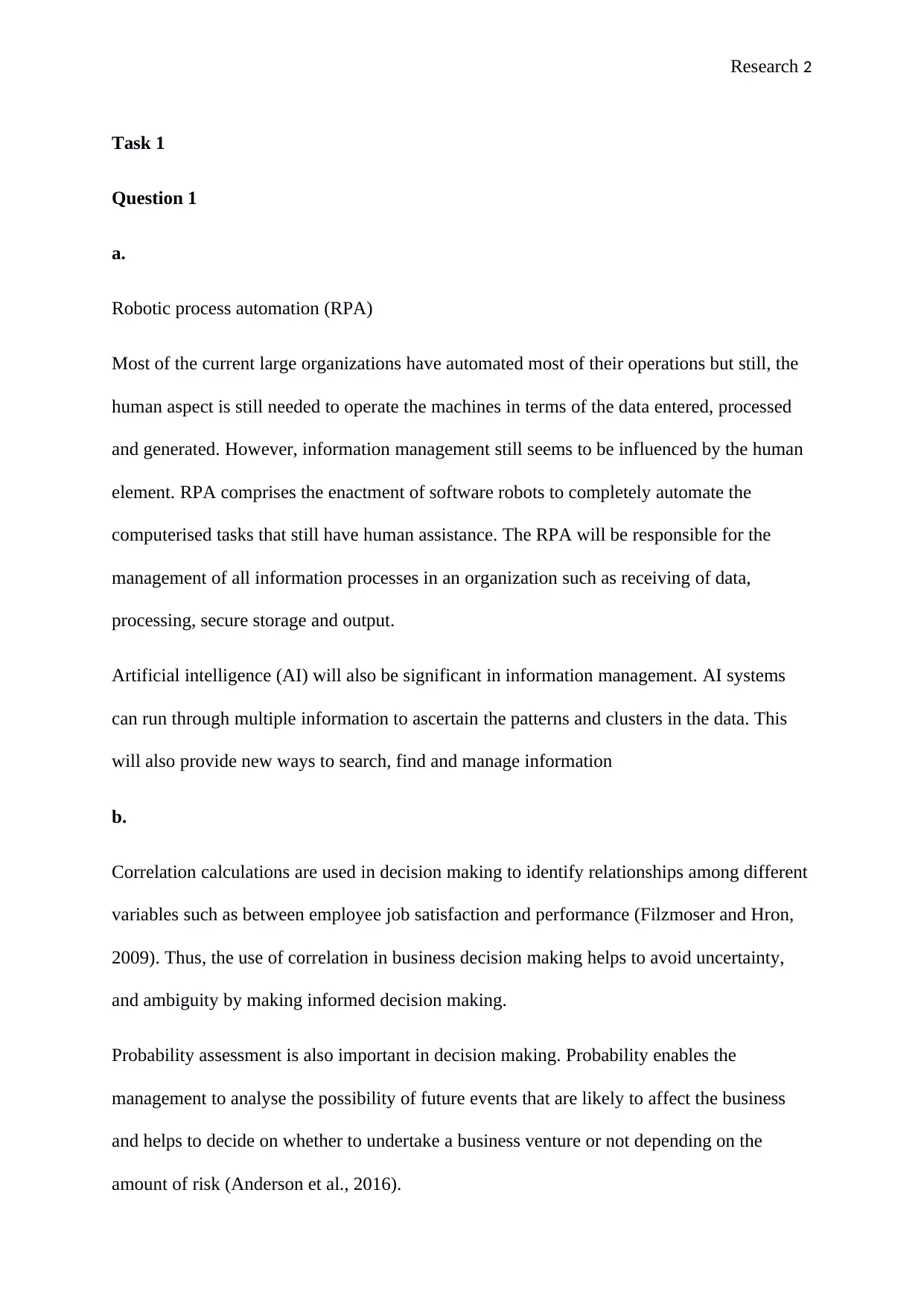
Research 2
Task 1
Question 1
a.
Robotic process automation (RPA)
Most of the current large organizations have automated most of their operations but still, the
human aspect is still needed to operate the machines in terms of the data entered, processed
and generated. However, information management still seems to be influenced by the human
element. RPA comprises the enactment of software robots to completely automate the
computerised tasks that still have human assistance. The RPA will be responsible for the
management of all information processes in an organization such as receiving of data,
processing, secure storage and output.
Artificial intelligence (AI) will also be significant in information management. AI systems
can run through multiple information to ascertain the patterns and clusters in the data. This
will also provide new ways to search, find and manage information
b.
Correlation calculations are used in decision making to identify relationships among different
variables such as between employee job satisfaction and performance (Filzmoser and Hron,
2009). Thus, the use of correlation in business decision making helps to avoid uncertainty,
and ambiguity by making informed decision making.
Probability assessment is also important in decision making. Probability enables the
management to analyse the possibility of future events that are likely to affect the business
and helps to decide on whether to undertake a business venture or not depending on the
amount of risk (Anderson et al., 2016).
Task 1
Question 1
a.
Robotic process automation (RPA)
Most of the current large organizations have automated most of their operations but still, the
human aspect is still needed to operate the machines in terms of the data entered, processed
and generated. However, information management still seems to be influenced by the human
element. RPA comprises the enactment of software robots to completely automate the
computerised tasks that still have human assistance. The RPA will be responsible for the
management of all information processes in an organization such as receiving of data,
processing, secure storage and output.
Artificial intelligence (AI) will also be significant in information management. AI systems
can run through multiple information to ascertain the patterns and clusters in the data. This
will also provide new ways to search, find and manage information
b.
Correlation calculations are used in decision making to identify relationships among different
variables such as between employee job satisfaction and performance (Filzmoser and Hron,
2009). Thus, the use of correlation in business decision making helps to avoid uncertainty,
and ambiguity by making informed decision making.
Probability assessment is also important in decision making. Probability enables the
management to analyse the possibility of future events that are likely to affect the business
and helps to decide on whether to undertake a business venture or not depending on the
amount of risk (Anderson et al., 2016).
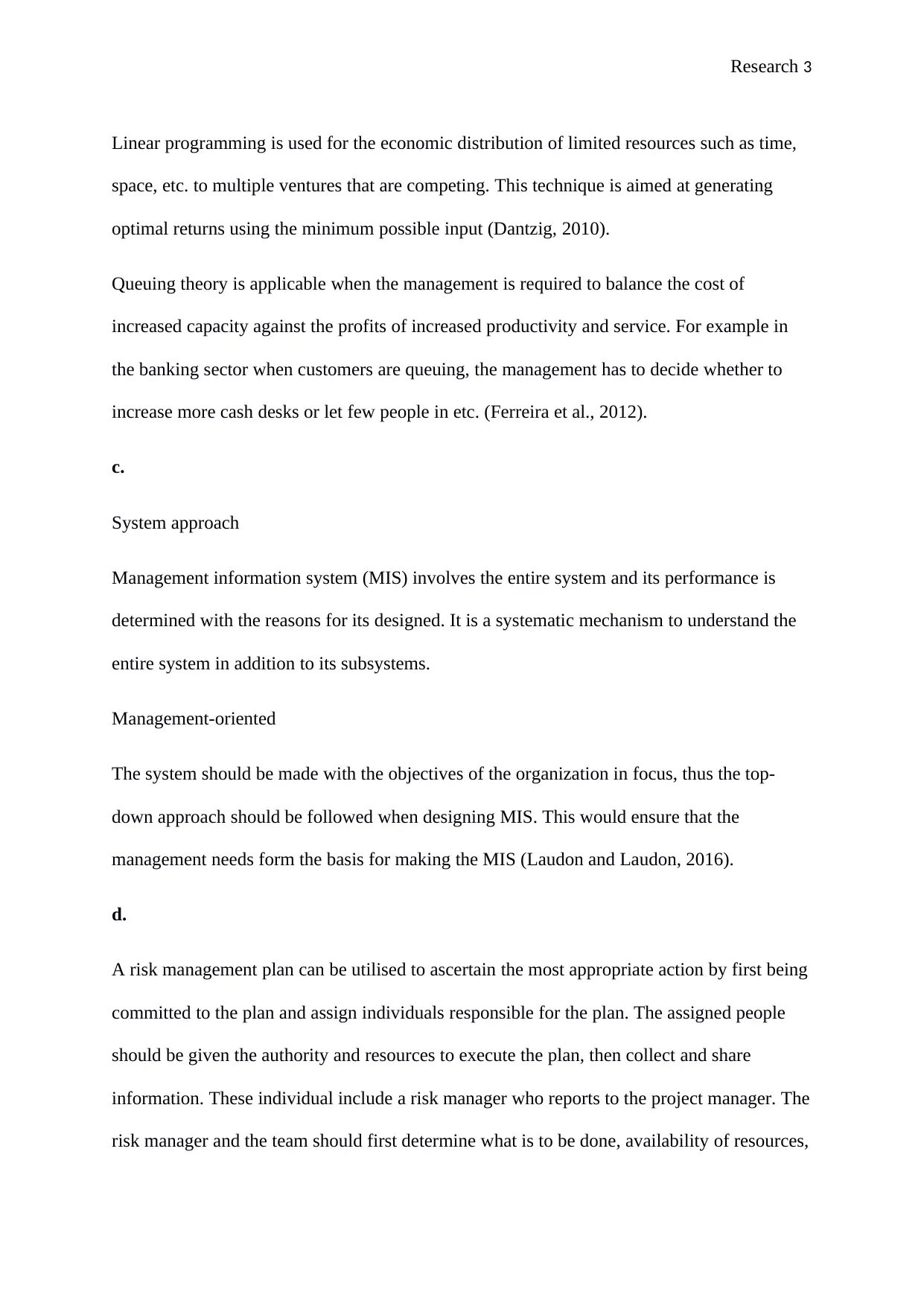
Research 3
Linear programming is used for the economic distribution of limited resources such as time,
space, etc. to multiple ventures that are competing. This technique is aimed at generating
optimal returns using the minimum possible input (Dantzig, 2010).
Queuing theory is applicable when the management is required to balance the cost of
increased capacity against the profits of increased productivity and service. For example in
the banking sector when customers are queuing, the management has to decide whether to
increase more cash desks or let few people in etc. (Ferreira et al., 2012).
c.
System approach
Management information system (MIS) involves the entire system and its performance is
determined with the reasons for its designed. It is a systematic mechanism to understand the
entire system in addition to its subsystems.
Management-oriented
The system should be made with the objectives of the organization in focus, thus the top-
down approach should be followed when designing MIS. This would ensure that the
management needs form the basis for making the MIS (Laudon and Laudon, 2016).
d.
A risk management plan can be utilised to ascertain the most appropriate action by first being
committed to the plan and assign individuals responsible for the plan. The assigned people
should be given the authority and resources to execute the plan, then collect and share
information. These individual include a risk manager who reports to the project manager. The
risk manager and the team should first determine what is to be done, availability of resources,
Linear programming is used for the economic distribution of limited resources such as time,
space, etc. to multiple ventures that are competing. This technique is aimed at generating
optimal returns using the minimum possible input (Dantzig, 2010).
Queuing theory is applicable when the management is required to balance the cost of
increased capacity against the profits of increased productivity and service. For example in
the banking sector when customers are queuing, the management has to decide whether to
increase more cash desks or let few people in etc. (Ferreira et al., 2012).
c.
System approach
Management information system (MIS) involves the entire system and its performance is
determined with the reasons for its designed. It is a systematic mechanism to understand the
entire system in addition to its subsystems.
Management-oriented
The system should be made with the objectives of the organization in focus, thus the top-
down approach should be followed when designing MIS. This would ensure that the
management needs form the basis for making the MIS (Laudon and Laudon, 2016).
d.
A risk management plan can be utilised to ascertain the most appropriate action by first being
committed to the plan and assign individuals responsible for the plan. The assigned people
should be given the authority and resources to execute the plan, then collect and share
information. These individual include a risk manager who reports to the project manager. The
risk manager and the team should first determine what is to be done, availability of resources,
⊘ This is a preview!⊘
Do you want full access?
Subscribe today to unlock all pages.

Trusted by 1+ million students worldwide
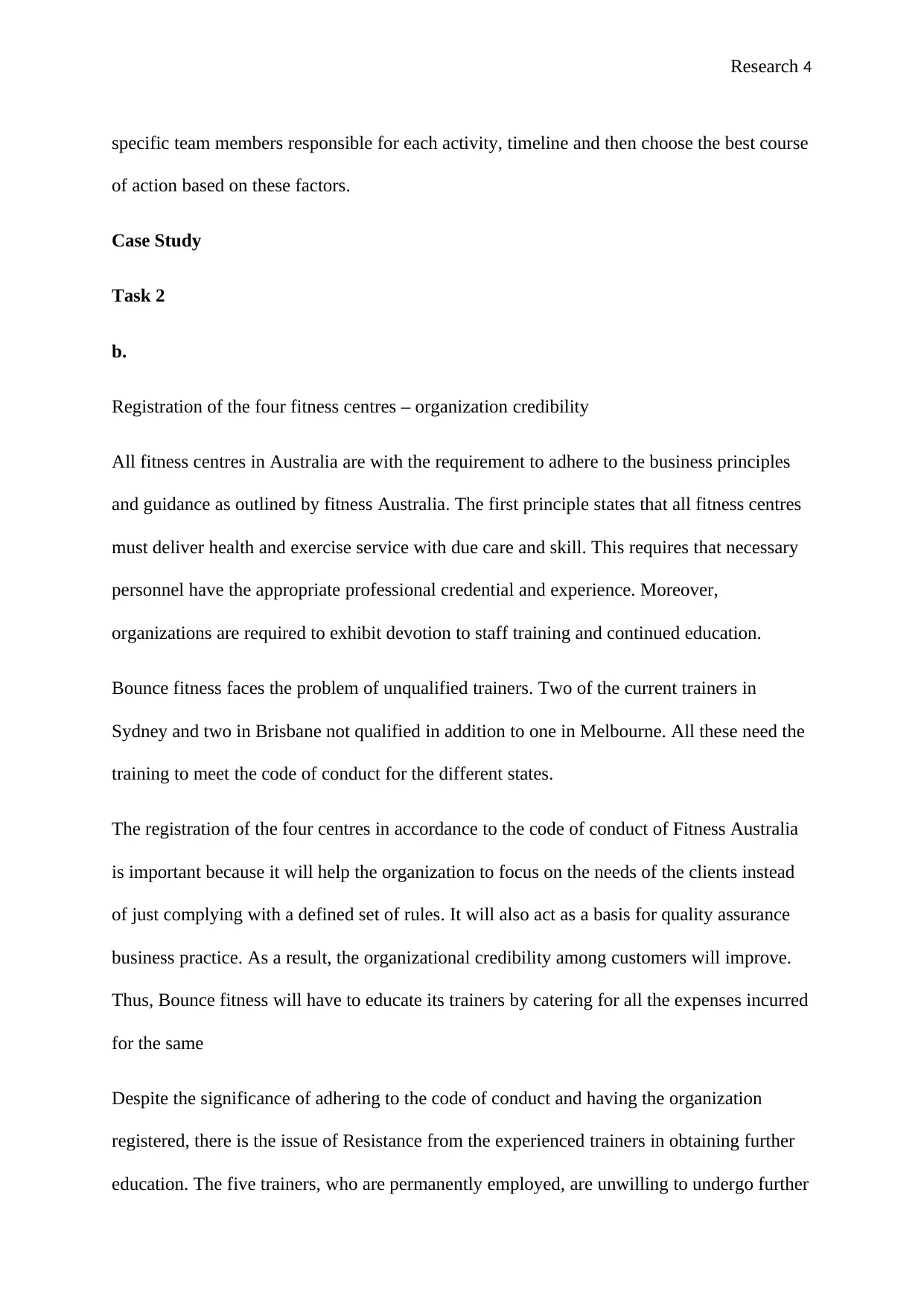
Research 4
specific team members responsible for each activity, timeline and then choose the best course
of action based on these factors.
Case Study
Task 2
b.
Registration of the four fitness centres – organization credibility
All fitness centres in Australia are with the requirement to adhere to the business principles
and guidance as outlined by fitness Australia. The first principle states that all fitness centres
must deliver health and exercise service with due care and skill. This requires that necessary
personnel have the appropriate professional credential and experience. Moreover,
organizations are required to exhibit devotion to staff training and continued education.
Bounce fitness faces the problem of unqualified trainers. Two of the current trainers in
Sydney and two in Brisbane not qualified in addition to one in Melbourne. All these need the
training to meet the code of conduct for the different states.
The registration of the four centres in accordance to the code of conduct of Fitness Australia
is important because it will help the organization to focus on the needs of the clients instead
of just complying with a defined set of rules. It will also act as a basis for quality assurance
business practice. As a result, the organizational credibility among customers will improve.
Thus, Bounce fitness will have to educate its trainers by catering for all the expenses incurred
for the same
Despite the significance of adhering to the code of conduct and having the organization
registered, there is the issue of Resistance from the experienced trainers in obtaining further
education. The five trainers, who are permanently employed, are unwilling to undergo further
specific team members responsible for each activity, timeline and then choose the best course
of action based on these factors.
Case Study
Task 2
b.
Registration of the four fitness centres – organization credibility
All fitness centres in Australia are with the requirement to adhere to the business principles
and guidance as outlined by fitness Australia. The first principle states that all fitness centres
must deliver health and exercise service with due care and skill. This requires that necessary
personnel have the appropriate professional credential and experience. Moreover,
organizations are required to exhibit devotion to staff training and continued education.
Bounce fitness faces the problem of unqualified trainers. Two of the current trainers in
Sydney and two in Brisbane not qualified in addition to one in Melbourne. All these need the
training to meet the code of conduct for the different states.
The registration of the four centres in accordance to the code of conduct of Fitness Australia
is important because it will help the organization to focus on the needs of the clients instead
of just complying with a defined set of rules. It will also act as a basis for quality assurance
business practice. As a result, the organizational credibility among customers will improve.
Thus, Bounce fitness will have to educate its trainers by catering for all the expenses incurred
for the same
Despite the significance of adhering to the code of conduct and having the organization
registered, there is the issue of Resistance from the experienced trainers in obtaining further
education. The five trainers, who are permanently employed, are unwilling to undergo further
Paraphrase This Document
Need a fresh take? Get an instant paraphrase of this document with our AI Paraphraser
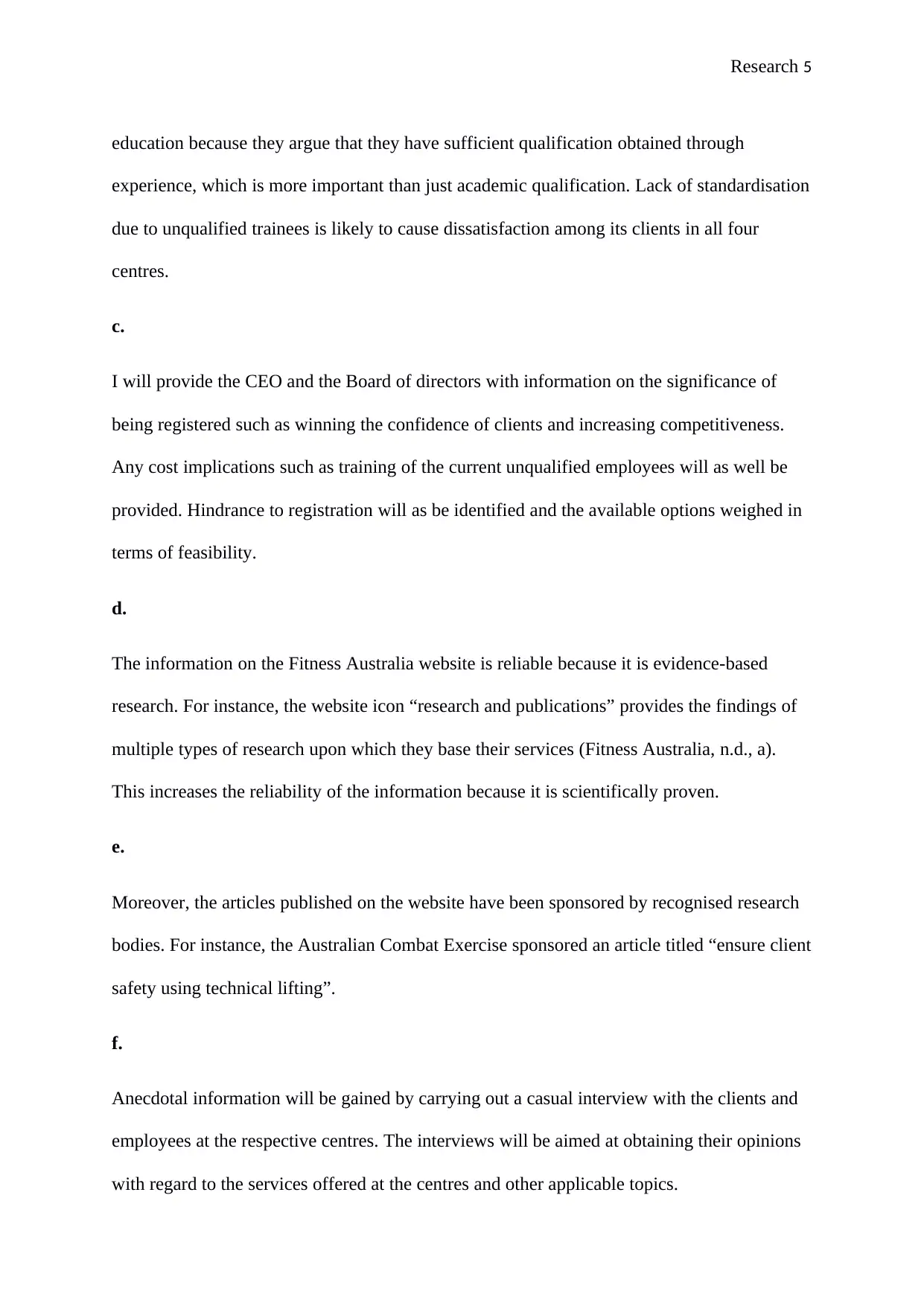
Research 5
education because they argue that they have sufficient qualification obtained through
experience, which is more important than just academic qualification. Lack of standardisation
due to unqualified trainees is likely to cause dissatisfaction among its clients in all four
centres.
c.
I will provide the CEO and the Board of directors with information on the significance of
being registered such as winning the confidence of clients and increasing competitiveness.
Any cost implications such as training of the current unqualified employees will as well be
provided. Hindrance to registration will as be identified and the available options weighed in
terms of feasibility.
d.
The information on the Fitness Australia website is reliable because it is evidence-based
research. For instance, the website icon “research and publications” provides the findings of
multiple types of research upon which they base their services (Fitness Australia, n.d., a).
This increases the reliability of the information because it is scientifically proven.
e.
Moreover, the articles published on the website have been sponsored by recognised research
bodies. For instance, the Australian Combat Exercise sponsored an article titled “ensure client
safety using technical lifting”.
f.
Anecdotal information will be gained by carrying out a casual interview with the clients and
employees at the respective centres. The interviews will be aimed at obtaining their opinions
with regard to the services offered at the centres and other applicable topics.
education because they argue that they have sufficient qualification obtained through
experience, which is more important than just academic qualification. Lack of standardisation
due to unqualified trainees is likely to cause dissatisfaction among its clients in all four
centres.
c.
I will provide the CEO and the Board of directors with information on the significance of
being registered such as winning the confidence of clients and increasing competitiveness.
Any cost implications such as training of the current unqualified employees will as well be
provided. Hindrance to registration will as be identified and the available options weighed in
terms of feasibility.
d.
The information on the Fitness Australia website is reliable because it is evidence-based
research. For instance, the website icon “research and publications” provides the findings of
multiple types of research upon which they base their services (Fitness Australia, n.d., a).
This increases the reliability of the information because it is scientifically proven.
e.
Moreover, the articles published on the website have been sponsored by recognised research
bodies. For instance, the Australian Combat Exercise sponsored an article titled “ensure client
safety using technical lifting”.
f.
Anecdotal information will be gained by carrying out a casual interview with the clients and
employees at the respective centres. The interviews will be aimed at obtaining their opinions
with regard to the services offered at the centres and other applicable topics.
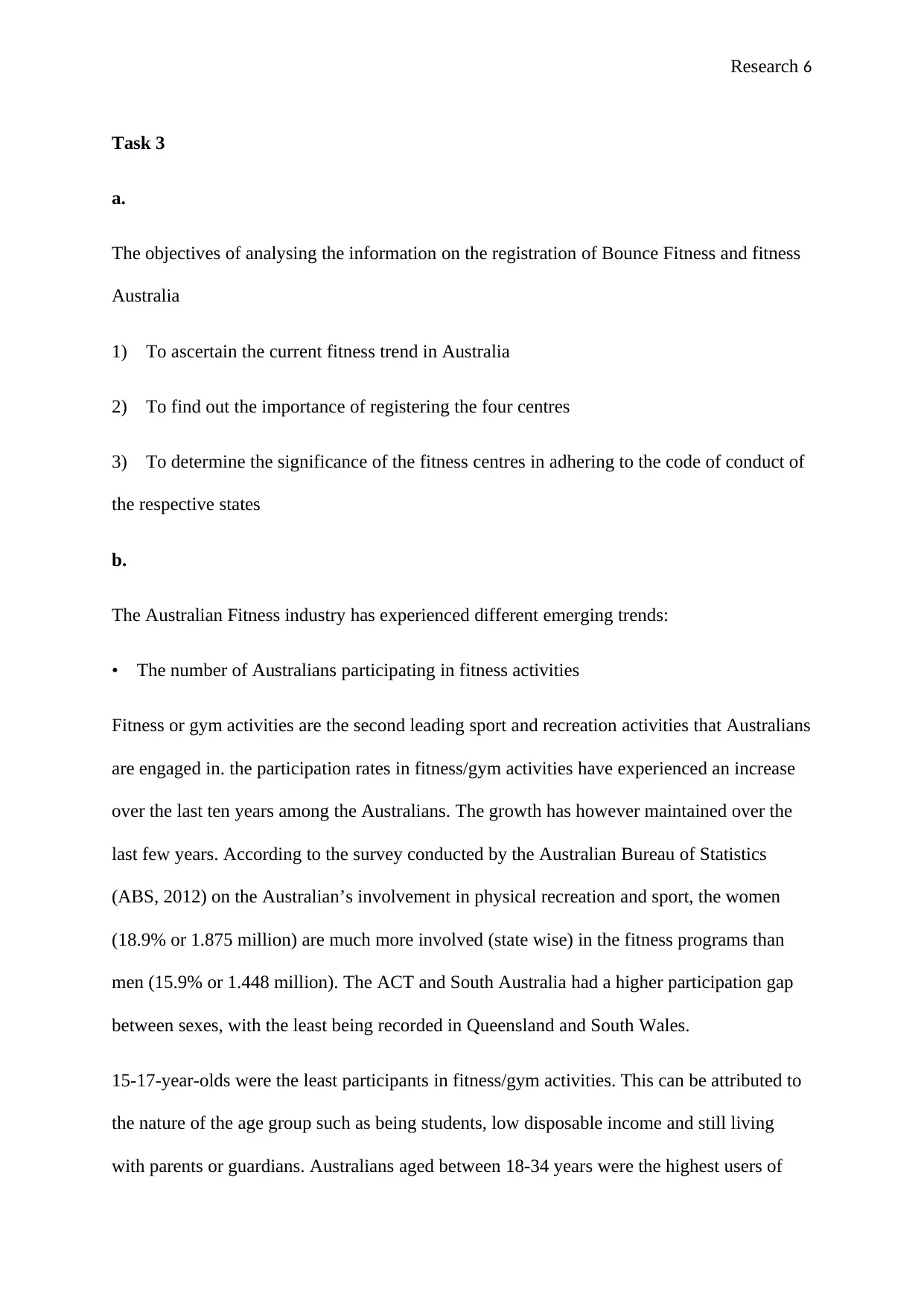
Research 6
Task 3
a.
The objectives of analysing the information on the registration of Bounce Fitness and fitness
Australia
1) To ascertain the current fitness trend in Australia
2) To find out the importance of registering the four centres
3) To determine the significance of the fitness centres in adhering to the code of conduct of
the respective states
b.
The Australian Fitness industry has experienced different emerging trends:
• The number of Australians participating in fitness activities
Fitness or gym activities are the second leading sport and recreation activities that Australians
are engaged in. the participation rates in fitness/gym activities have experienced an increase
over the last ten years among the Australians. The growth has however maintained over the
last few years. According to the survey conducted by the Australian Bureau of Statistics
(ABS, 2012) on the Australian’s involvement in physical recreation and sport, the women
(18.9% or 1.875 million) are much more involved (state wise) in the fitness programs than
men (15.9% or 1.448 million). The ACT and South Australia had a higher participation gap
between sexes, with the least being recorded in Queensland and South Wales.
15-17-year-olds were the least participants in fitness/gym activities. This can be attributed to
the nature of the age group such as being students, low disposable income and still living
with parents or guardians. Australians aged between 18-34 years were the highest users of
Task 3
a.
The objectives of analysing the information on the registration of Bounce Fitness and fitness
Australia
1) To ascertain the current fitness trend in Australia
2) To find out the importance of registering the four centres
3) To determine the significance of the fitness centres in adhering to the code of conduct of
the respective states
b.
The Australian Fitness industry has experienced different emerging trends:
• The number of Australians participating in fitness activities
Fitness or gym activities are the second leading sport and recreation activities that Australians
are engaged in. the participation rates in fitness/gym activities have experienced an increase
over the last ten years among the Australians. The growth has however maintained over the
last few years. According to the survey conducted by the Australian Bureau of Statistics
(ABS, 2012) on the Australian’s involvement in physical recreation and sport, the women
(18.9% or 1.875 million) are much more involved (state wise) in the fitness programs than
men (15.9% or 1.448 million). The ACT and South Australia had a higher participation gap
between sexes, with the least being recorded in Queensland and South Wales.
15-17-year-olds were the least participants in fitness/gym activities. This can be attributed to
the nature of the age group such as being students, low disposable income and still living
with parents or guardians. Australians aged between 18-34 years were the highest users of
⊘ This is a preview!⊘
Do you want full access?
Subscribe today to unlock all pages.

Trusted by 1+ million students worldwide
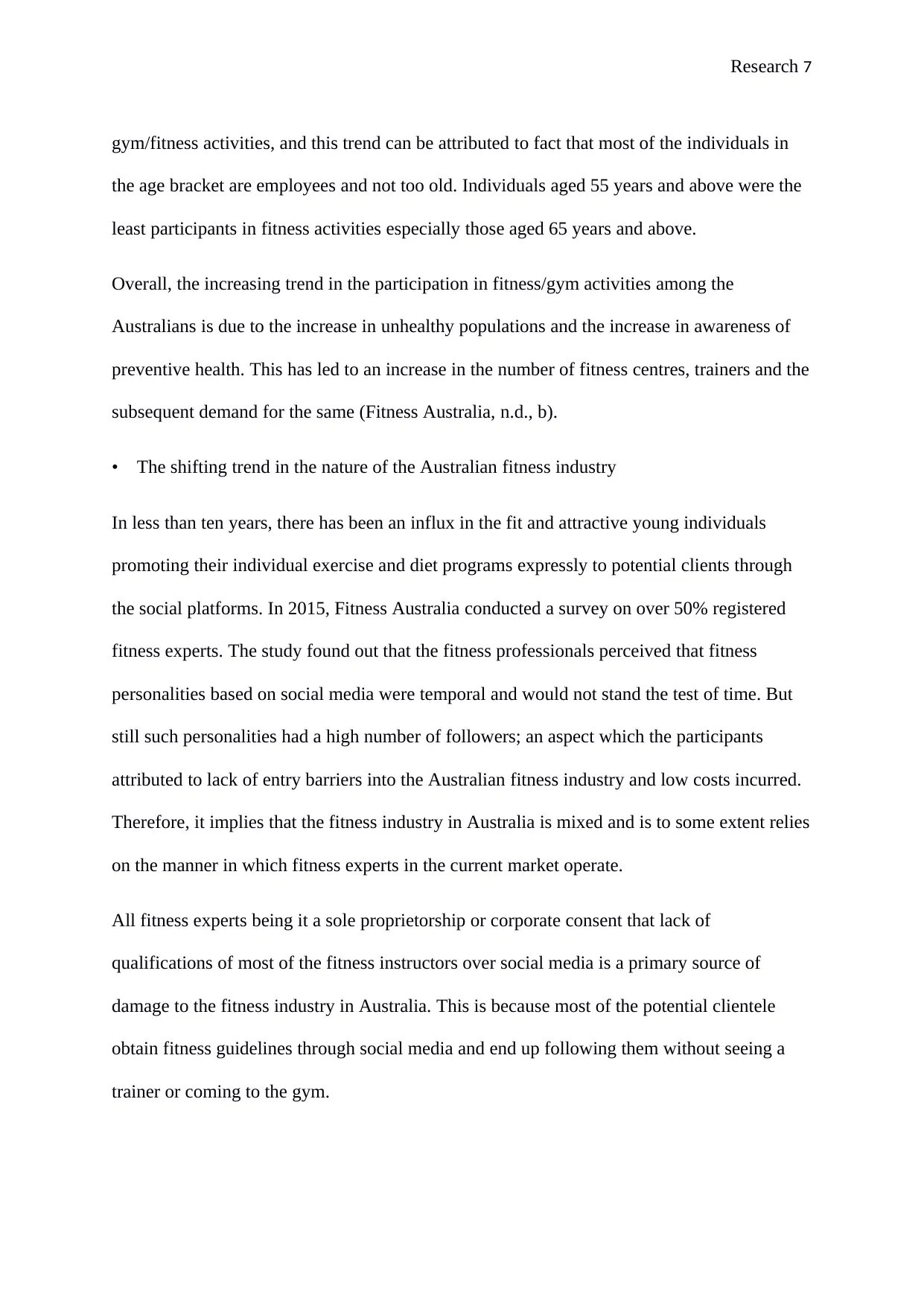
Research 7
gym/fitness activities, and this trend can be attributed to fact that most of the individuals in
the age bracket are employees and not too old. Individuals aged 55 years and above were the
least participants in fitness activities especially those aged 65 years and above.
Overall, the increasing trend in the participation in fitness/gym activities among the
Australians is due to the increase in unhealthy populations and the increase in awareness of
preventive health. This has led to an increase in the number of fitness centres, trainers and the
subsequent demand for the same (Fitness Australia, n.d., b).
• The shifting trend in the nature of the Australian fitness industry
In less than ten years, there has been an influx in the fit and attractive young individuals
promoting their individual exercise and diet programs expressly to potential clients through
the social platforms. In 2015, Fitness Australia conducted a survey on over 50% registered
fitness experts. The study found out that the fitness professionals perceived that fitness
personalities based on social media were temporal and would not stand the test of time. But
still such personalities had a high number of followers; an aspect which the participants
attributed to lack of entry barriers into the Australian fitness industry and low costs incurred.
Therefore, it implies that the fitness industry in Australia is mixed and is to some extent relies
on the manner in which fitness experts in the current market operate.
All fitness experts being it a sole proprietorship or corporate consent that lack of
qualifications of most of the fitness instructors over social media is a primary source of
damage to the fitness industry in Australia. This is because most of the potential clientele
obtain fitness guidelines through social media and end up following them without seeing a
trainer or coming to the gym.
gym/fitness activities, and this trend can be attributed to fact that most of the individuals in
the age bracket are employees and not too old. Individuals aged 55 years and above were the
least participants in fitness activities especially those aged 65 years and above.
Overall, the increasing trend in the participation in fitness/gym activities among the
Australians is due to the increase in unhealthy populations and the increase in awareness of
preventive health. This has led to an increase in the number of fitness centres, trainers and the
subsequent demand for the same (Fitness Australia, n.d., b).
• The shifting trend in the nature of the Australian fitness industry
In less than ten years, there has been an influx in the fit and attractive young individuals
promoting their individual exercise and diet programs expressly to potential clients through
the social platforms. In 2015, Fitness Australia conducted a survey on over 50% registered
fitness experts. The study found out that the fitness professionals perceived that fitness
personalities based on social media were temporal and would not stand the test of time. But
still such personalities had a high number of followers; an aspect which the participants
attributed to lack of entry barriers into the Australian fitness industry and low costs incurred.
Therefore, it implies that the fitness industry in Australia is mixed and is to some extent relies
on the manner in which fitness experts in the current market operate.
All fitness experts being it a sole proprietorship or corporate consent that lack of
qualifications of most of the fitness instructors over social media is a primary source of
damage to the fitness industry in Australia. This is because most of the potential clientele
obtain fitness guidelines through social media and end up following them without seeing a
trainer or coming to the gym.
Paraphrase This Document
Need a fresh take? Get an instant paraphrase of this document with our AI Paraphraser
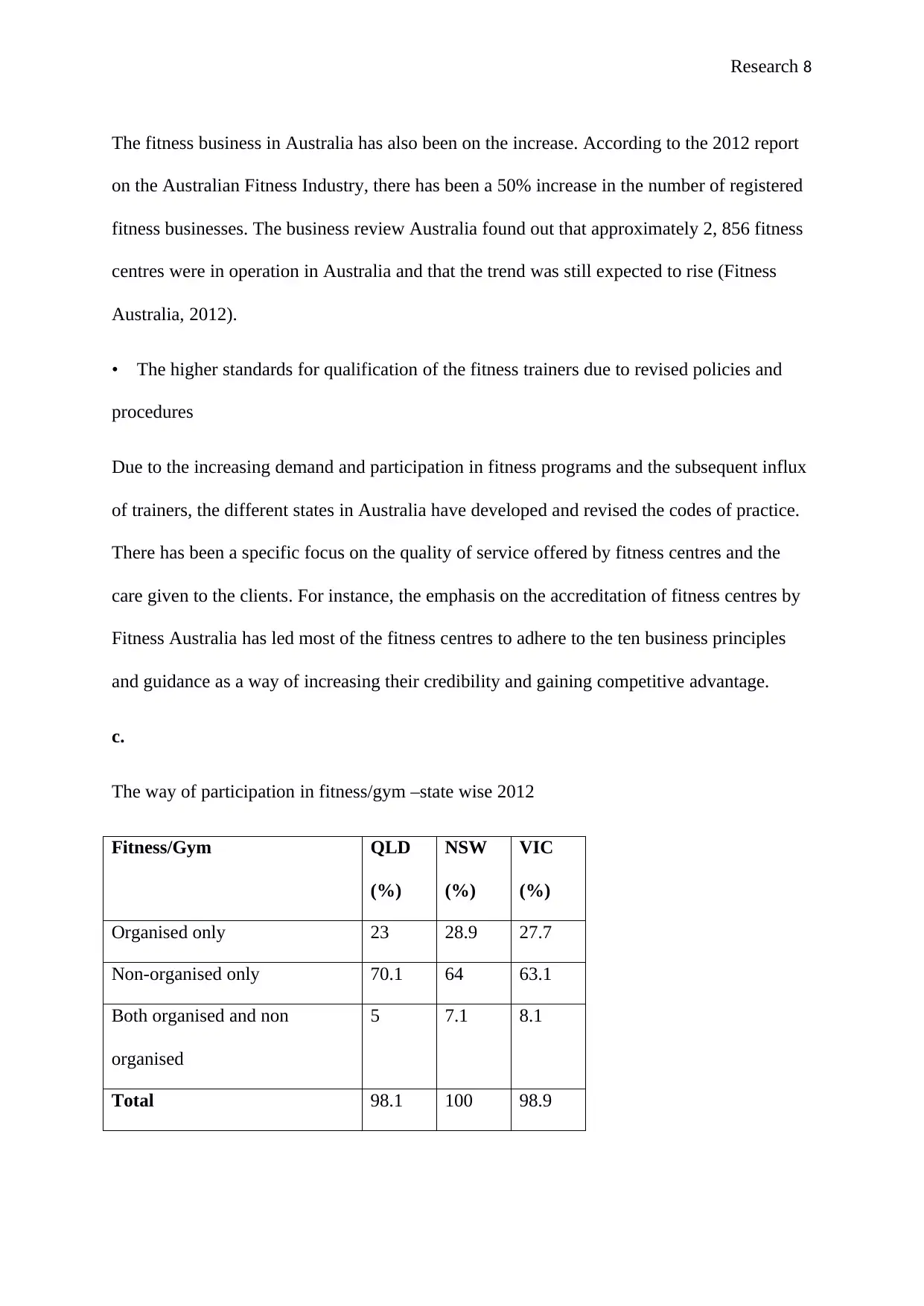
Research 8
The fitness business in Australia has also been on the increase. According to the 2012 report
on the Australian Fitness Industry, there has been a 50% increase in the number of registered
fitness businesses. The business review Australia found out that approximately 2, 856 fitness
centres were in operation in Australia and that the trend was still expected to rise (Fitness
Australia, 2012).
• The higher standards for qualification of the fitness trainers due to revised policies and
procedures
Due to the increasing demand and participation in fitness programs and the subsequent influx
of trainers, the different states in Australia have developed and revised the codes of practice.
There has been a specific focus on the quality of service offered by fitness centres and the
care given to the clients. For instance, the emphasis on the accreditation of fitness centres by
Fitness Australia has led most of the fitness centres to adhere to the ten business principles
and guidance as a way of increasing their credibility and gaining competitive advantage.
c.
The way of participation in fitness/gym –state wise 2012
Fitness/Gym QLD
(%)
NSW
(%)
VIC
(%)
Organised only 23 28.9 27.7
Non-organised only 70.1 64 63.1
Both organised and non
organised
5 7.1 8.1
Total 98.1 100 98.9
The fitness business in Australia has also been on the increase. According to the 2012 report
on the Australian Fitness Industry, there has been a 50% increase in the number of registered
fitness businesses. The business review Australia found out that approximately 2, 856 fitness
centres were in operation in Australia and that the trend was still expected to rise (Fitness
Australia, 2012).
• The higher standards for qualification of the fitness trainers due to revised policies and
procedures
Due to the increasing demand and participation in fitness programs and the subsequent influx
of trainers, the different states in Australia have developed and revised the codes of practice.
There has been a specific focus on the quality of service offered by fitness centres and the
care given to the clients. For instance, the emphasis on the accreditation of fitness centres by
Fitness Australia has led most of the fitness centres to adhere to the ten business principles
and guidance as a way of increasing their credibility and gaining competitive advantage.
c.
The way of participation in fitness/gym –state wise 2012
Fitness/Gym QLD
(%)
NSW
(%)
VIC
(%)
Organised only 23 28.9 27.7
Non-organised only 70.1 64 63.1
Both organised and non
organised
5 7.1 8.1
Total 98.1 100 98.9
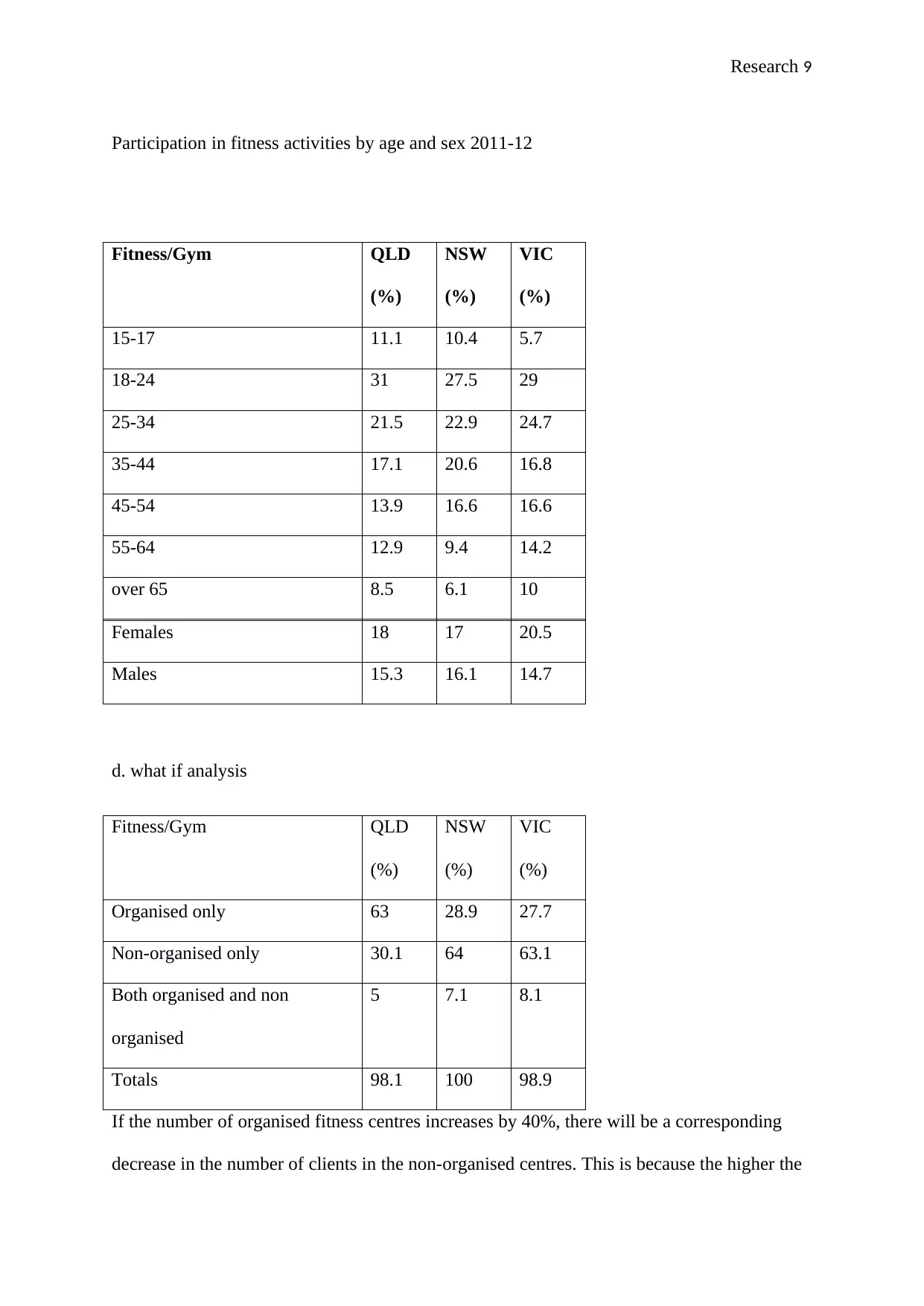
Research 9
Participation in fitness activities by age and sex 2011-12
Fitness/Gym QLD
(%)
NSW
(%)
VIC
(%)
15-17 11.1 10.4 5.7
18-24 31 27.5 29
25-34 21.5 22.9 24.7
35-44 17.1 20.6 16.8
45-54 13.9 16.6 16.6
55-64 12.9 9.4 14.2
over 65 8.5 6.1 10
Females 18 17 20.5
Males 15.3 16.1 14.7
d. what if analysis
Fitness/Gym QLD
(%)
NSW
(%)
VIC
(%)
Organised only 63 28.9 27.7
Non-organised only 30.1 64 63.1
Both organised and non
organised
5 7.1 8.1
Totals 98.1 100 98.9
If the number of organised fitness centres increases by 40%, there will be a corresponding
decrease in the number of clients in the non-organised centres. This is because the higher the
Participation in fitness activities by age and sex 2011-12
Fitness/Gym QLD
(%)
NSW
(%)
VIC
(%)
15-17 11.1 10.4 5.7
18-24 31 27.5 29
25-34 21.5 22.9 24.7
35-44 17.1 20.6 16.8
45-54 13.9 16.6 16.6
55-64 12.9 9.4 14.2
over 65 8.5 6.1 10
Females 18 17 20.5
Males 15.3 16.1 14.7
d. what if analysis
Fitness/Gym QLD
(%)
NSW
(%)
VIC
(%)
Organised only 63 28.9 27.7
Non-organised only 30.1 64 63.1
Both organised and non
organised
5 7.1 8.1
Totals 98.1 100 98.9
If the number of organised fitness centres increases by 40%, there will be a corresponding
decrease in the number of clients in the non-organised centres. This is because the higher the
⊘ This is a preview!⊘
Do you want full access?
Subscribe today to unlock all pages.

Trusted by 1+ million students worldwide
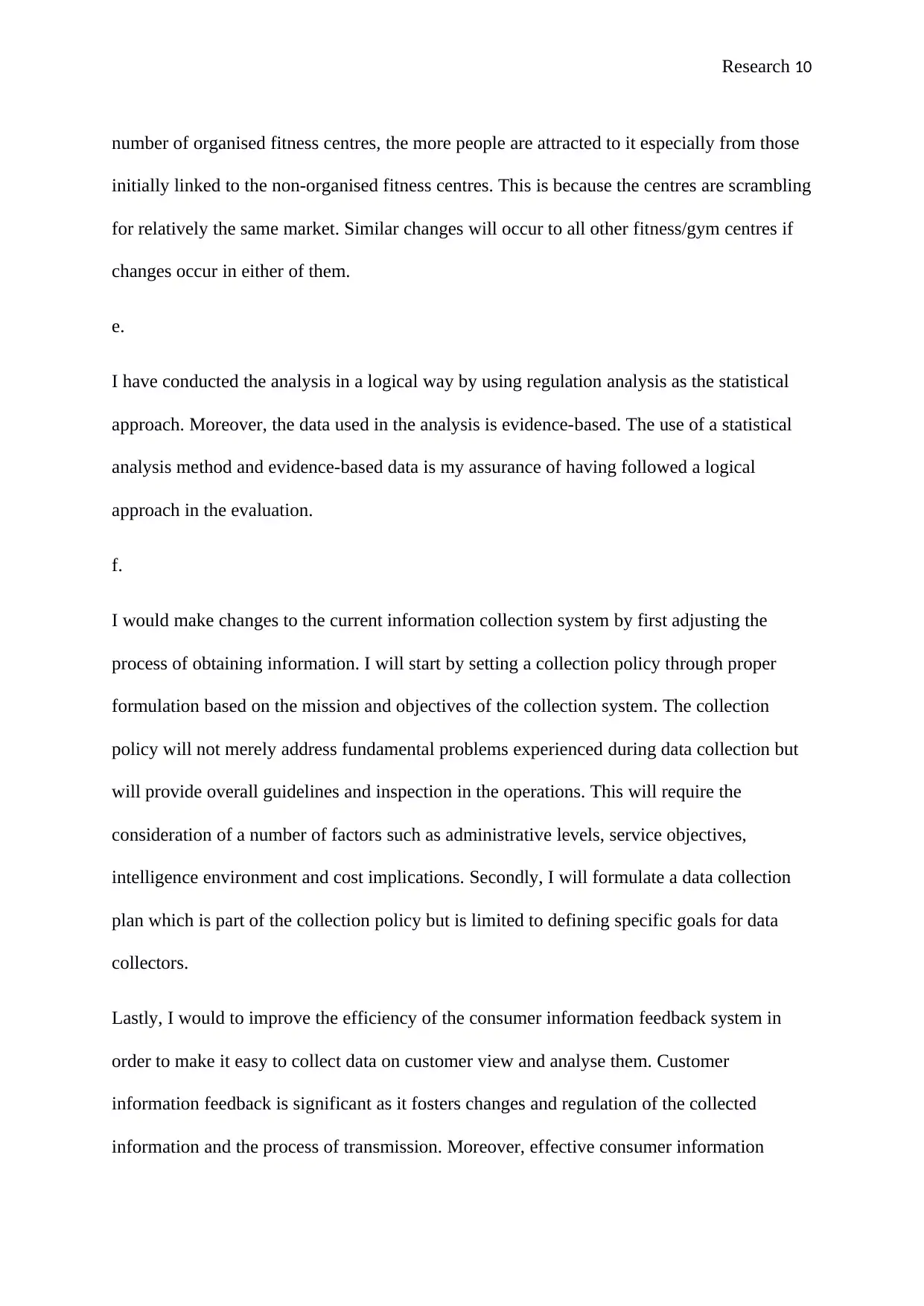
Research 10
number of organised fitness centres, the more people are attracted to it especially from those
initially linked to the non-organised fitness centres. This is because the centres are scrambling
for relatively the same market. Similar changes will occur to all other fitness/gym centres if
changes occur in either of them.
e.
I have conducted the analysis in a logical way by using regulation analysis as the statistical
approach. Moreover, the data used in the analysis is evidence-based. The use of a statistical
analysis method and evidence-based data is my assurance of having followed a logical
approach in the evaluation.
f.
I would make changes to the current information collection system by first adjusting the
process of obtaining information. I will start by setting a collection policy through proper
formulation based on the mission and objectives of the collection system. The collection
policy will not merely address fundamental problems experienced during data collection but
will provide overall guidelines and inspection in the operations. This will require the
consideration of a number of factors such as administrative levels, service objectives,
intelligence environment and cost implications. Secondly, I will formulate a data collection
plan which is part of the collection policy but is limited to defining specific goals for data
collectors.
Lastly, I would to improve the efficiency of the consumer information feedback system in
order to make it easy to collect data on customer view and analyse them. Customer
information feedback is significant as it fosters changes and regulation of the collected
information and the process of transmission. Moreover, effective consumer information
number of organised fitness centres, the more people are attracted to it especially from those
initially linked to the non-organised fitness centres. This is because the centres are scrambling
for relatively the same market. Similar changes will occur to all other fitness/gym centres if
changes occur in either of them.
e.
I have conducted the analysis in a logical way by using regulation analysis as the statistical
approach. Moreover, the data used in the analysis is evidence-based. The use of a statistical
analysis method and evidence-based data is my assurance of having followed a logical
approach in the evaluation.
f.
I would make changes to the current information collection system by first adjusting the
process of obtaining information. I will start by setting a collection policy through proper
formulation based on the mission and objectives of the collection system. The collection
policy will not merely address fundamental problems experienced during data collection but
will provide overall guidelines and inspection in the operations. This will require the
consideration of a number of factors such as administrative levels, service objectives,
intelligence environment and cost implications. Secondly, I will formulate a data collection
plan which is part of the collection policy but is limited to defining specific goals for data
collectors.
Lastly, I would to improve the efficiency of the consumer information feedback system in
order to make it easy to collect data on customer view and analyse them. Customer
information feedback is significant as it fosters changes and regulation of the collected
information and the process of transmission. Moreover, effective consumer information
Paraphrase This Document
Need a fresh take? Get an instant paraphrase of this document with our AI Paraphraser
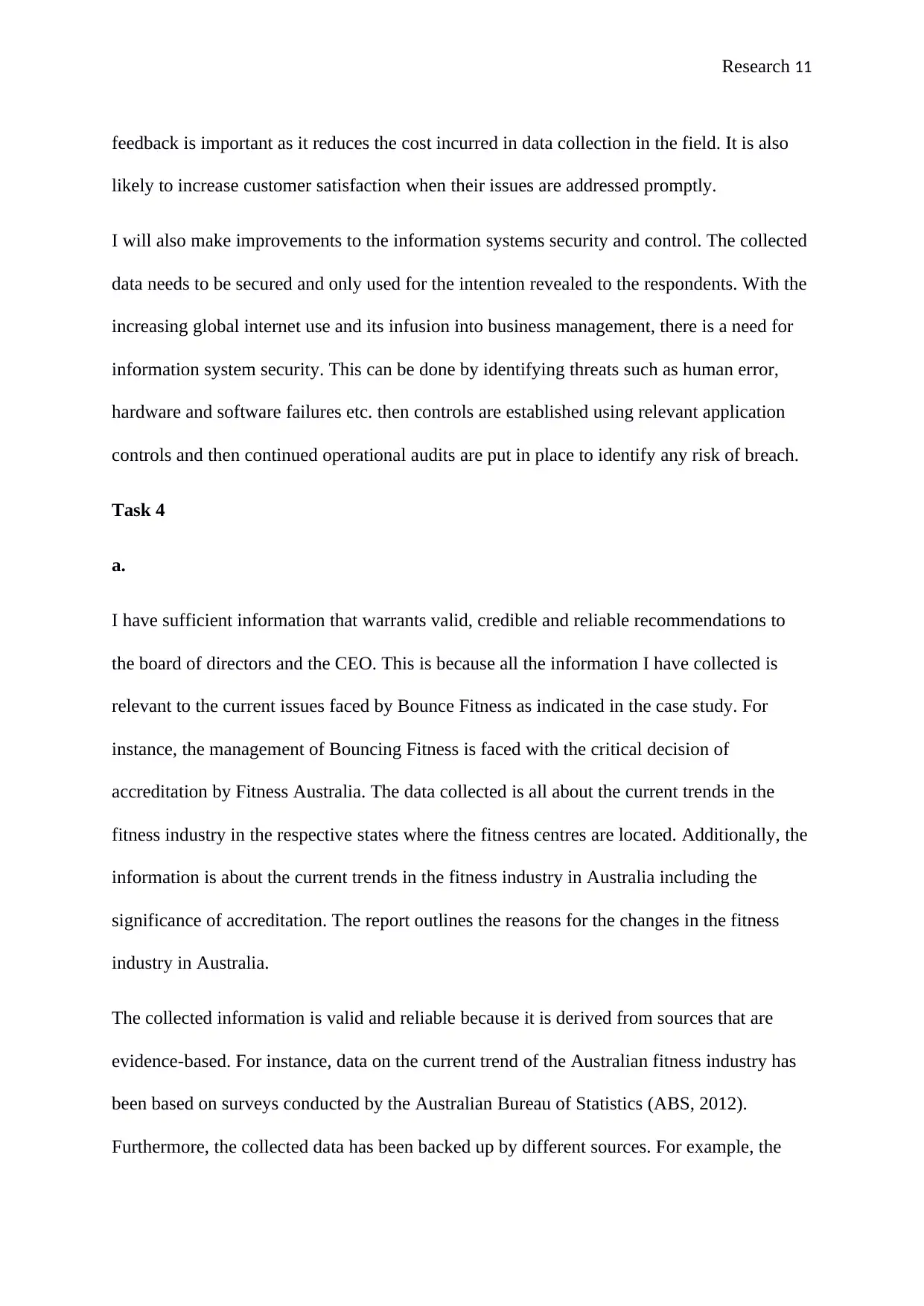
Research 11
feedback is important as it reduces the cost incurred in data collection in the field. It is also
likely to increase customer satisfaction when their issues are addressed promptly.
I will also make improvements to the information systems security and control. The collected
data needs to be secured and only used for the intention revealed to the respondents. With the
increasing global internet use and its infusion into business management, there is a need for
information system security. This can be done by identifying threats such as human error,
hardware and software failures etc. then controls are established using relevant application
controls and then continued operational audits are put in place to identify any risk of breach.
Task 4
a.
I have sufficient information that warrants valid, credible and reliable recommendations to
the board of directors and the CEO. This is because all the information I have collected is
relevant to the current issues faced by Bounce Fitness as indicated in the case study. For
instance, the management of Bouncing Fitness is faced with the critical decision of
accreditation by Fitness Australia. The data collected is all about the current trends in the
fitness industry in the respective states where the fitness centres are located. Additionally, the
information is about the current trends in the fitness industry in Australia including the
significance of accreditation. The report outlines the reasons for the changes in the fitness
industry in Australia.
The collected information is valid and reliable because it is derived from sources that are
evidence-based. For instance, data on the current trend of the Australian fitness industry has
been based on surveys conducted by the Australian Bureau of Statistics (ABS, 2012).
Furthermore, the collected data has been backed up by different sources. For example, the
feedback is important as it reduces the cost incurred in data collection in the field. It is also
likely to increase customer satisfaction when their issues are addressed promptly.
I will also make improvements to the information systems security and control. The collected
data needs to be secured and only used for the intention revealed to the respondents. With the
increasing global internet use and its infusion into business management, there is a need for
information system security. This can be done by identifying threats such as human error,
hardware and software failures etc. then controls are established using relevant application
controls and then continued operational audits are put in place to identify any risk of breach.
Task 4
a.
I have sufficient information that warrants valid, credible and reliable recommendations to
the board of directors and the CEO. This is because all the information I have collected is
relevant to the current issues faced by Bounce Fitness as indicated in the case study. For
instance, the management of Bouncing Fitness is faced with the critical decision of
accreditation by Fitness Australia. The data collected is all about the current trends in the
fitness industry in the respective states where the fitness centres are located. Additionally, the
information is about the current trends in the fitness industry in Australia including the
significance of accreditation. The report outlines the reasons for the changes in the fitness
industry in Australia.
The collected information is valid and reliable because it is derived from sources that are
evidence-based. For instance, data on the current trend of the Australian fitness industry has
been based on surveys conducted by the Australian Bureau of Statistics (ABS, 2012).
Furthermore, the collected data has been backed up by different sources. For example, the
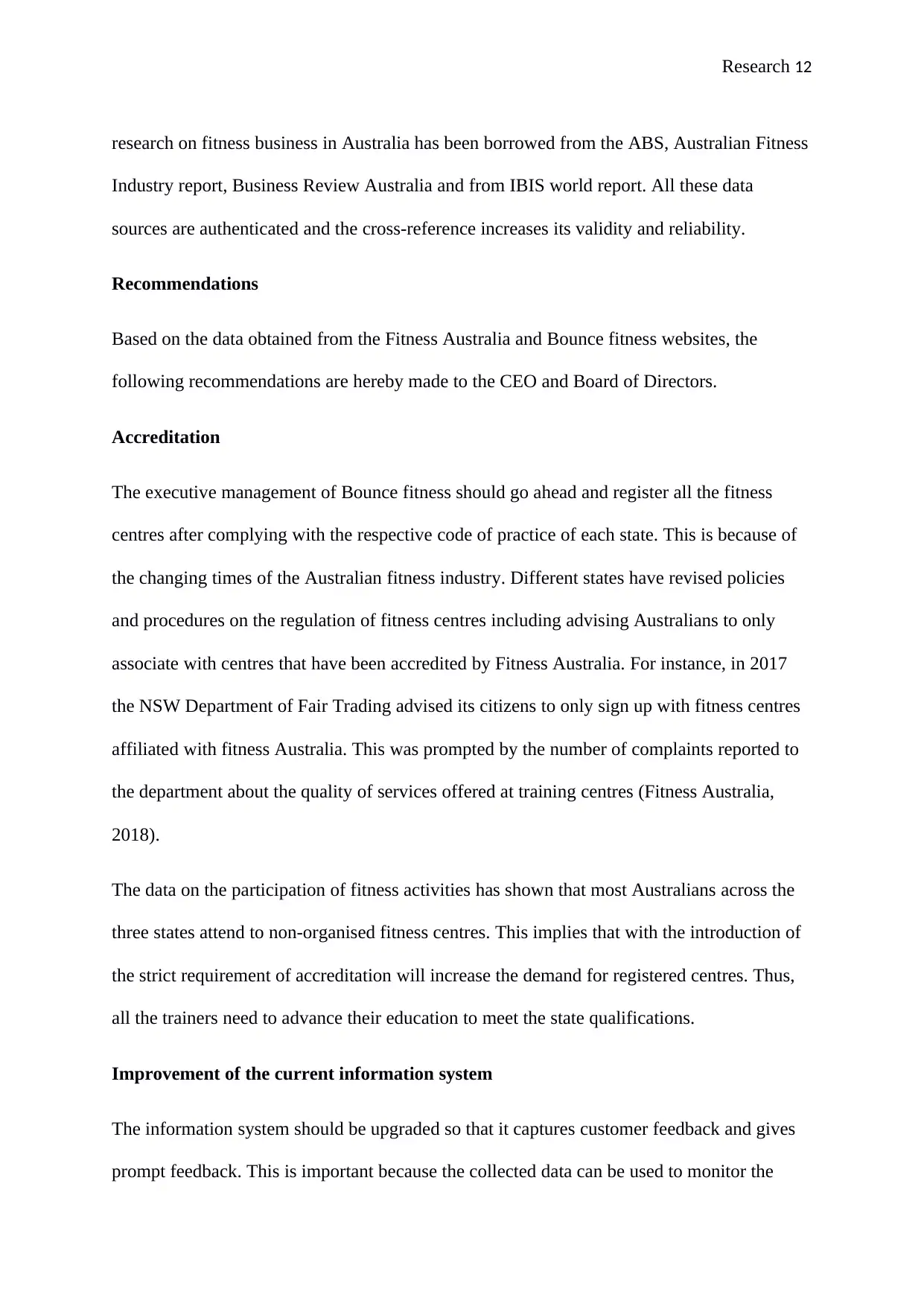
Research 12
research on fitness business in Australia has been borrowed from the ABS, Australian Fitness
Industry report, Business Review Australia and from IBIS world report. All these data
sources are authenticated and the cross-reference increases its validity and reliability.
Recommendations
Based on the data obtained from the Fitness Australia and Bounce fitness websites, the
following recommendations are hereby made to the CEO and Board of Directors.
Accreditation
The executive management of Bounce fitness should go ahead and register all the fitness
centres after complying with the respective code of practice of each state. This is because of
the changing times of the Australian fitness industry. Different states have revised policies
and procedures on the regulation of fitness centres including advising Australians to only
associate with centres that have been accredited by Fitness Australia. For instance, in 2017
the NSW Department of Fair Trading advised its citizens to only sign up with fitness centres
affiliated with fitness Australia. This was prompted by the number of complaints reported to
the department about the quality of services offered at training centres (Fitness Australia,
2018).
The data on the participation of fitness activities has shown that most Australians across the
three states attend to non-organised fitness centres. This implies that with the introduction of
the strict requirement of accreditation will increase the demand for registered centres. Thus,
all the trainers need to advance their education to meet the state qualifications.
Improvement of the current information system
The information system should be upgraded so that it captures customer feedback and gives
prompt feedback. This is important because the collected data can be used to monitor the
research on fitness business in Australia has been borrowed from the ABS, Australian Fitness
Industry report, Business Review Australia and from IBIS world report. All these data
sources are authenticated and the cross-reference increases its validity and reliability.
Recommendations
Based on the data obtained from the Fitness Australia and Bounce fitness websites, the
following recommendations are hereby made to the CEO and Board of Directors.
Accreditation
The executive management of Bounce fitness should go ahead and register all the fitness
centres after complying with the respective code of practice of each state. This is because of
the changing times of the Australian fitness industry. Different states have revised policies
and procedures on the regulation of fitness centres including advising Australians to only
associate with centres that have been accredited by Fitness Australia. For instance, in 2017
the NSW Department of Fair Trading advised its citizens to only sign up with fitness centres
affiliated with fitness Australia. This was prompted by the number of complaints reported to
the department about the quality of services offered at training centres (Fitness Australia,
2018).
The data on the participation of fitness activities has shown that most Australians across the
three states attend to non-organised fitness centres. This implies that with the introduction of
the strict requirement of accreditation will increase the demand for registered centres. Thus,
all the trainers need to advance their education to meet the state qualifications.
Improvement of the current information system
The information system should be upgraded so that it captures customer feedback and gives
prompt feedback. This is important because the collected data can be used to monitor the
⊘ This is a preview!⊘
Do you want full access?
Subscribe today to unlock all pages.

Trusted by 1+ million students worldwide
1 out of 17
Your All-in-One AI-Powered Toolkit for Academic Success.
+13062052269
info@desklib.com
Available 24*7 on WhatsApp / Email
![[object Object]](/_next/static/media/star-bottom.7253800d.svg)
Unlock your academic potential
Copyright © 2020–2025 A2Z Services. All Rights Reserved. Developed and managed by ZUCOL.
